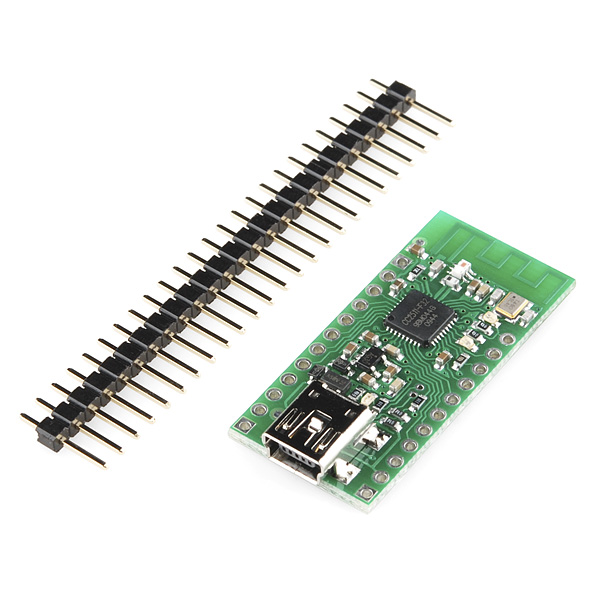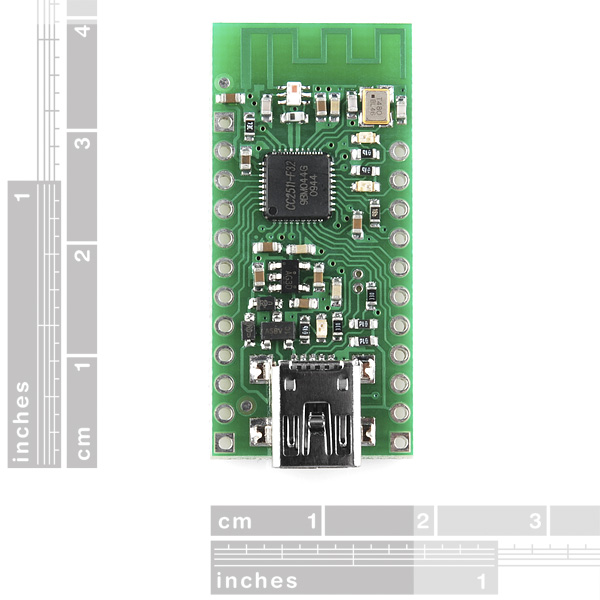Wixel
The Wixel is a great general-purpose module from Pololu. By taking advantage of the feature-rich CC2511F32 microcontroller from Texas Instruments, the Wixel provides integrated 2.4 GHz wireless communication, 32 KB of flash memory, 4 KB of RAM, full-speed USB interface and 15 general-purpose I/O lines (including 6 analog inputs). A single Wixel can be used as a computer-interface device, such as a USB-to-serial adapter, and it can even serve as the main controller for your system. With two or more modules you can take advantage of the Wixel’s wireless capabilities to build wireless networks.
The Wixel features a built-in USB bootloader that can be used in conjunction with Pololu's free Wixel Configuration Utility software to upload custom programs or precompiled, open-source apps to the Wixel (no external programmer is required). A growing selection of free apps lets you turn the Wixel into whatever you need for your current project. No programming experience or compiler software is required to use these apps: simply download a different app to reuse the Wixel in your next project! See the GitHub page below for the current selection of apps as well as the configuration tool. They plan to release additional apps in the future for wireless AVR/Arduino programming, wireless sensing, wireless motor driver interfaces, and more.
Note: The Wixel comes with break-away headers that can be soldered to the board.
- Full-speed USB
- 2.4 GHz Radio with 256 available channels that can be configured dynamically
- Programmable through USB bootloader (no external programmer required)
- Pre-compiled, open-source apps available
- Wixel SDK for developing your own applications in C using open source tools and libraries
- 0.1" pin spacing (compatible with standard breadboards and 0.1" perfboards)
- 3 indicator LEDs
- 15 user I/O lines, featuring 6 analog inputs, 2 USARTs (for serial or SPI), and 7 timer channels (capable of PWM)
- 4 KB of RAM and 29 KB of application program memory (flash)
- 0.7" × 1.5" (17.78mm x 38.1mm)
Wixel Product Help and Resources
Core Skill: Soldering
This skill defines how difficult the soldering is on a particular product. It might be a couple simple solder joints, or require special reflow tools.
Skill Level: Noob - Some basic soldering is required, but it is limited to a just a few pins, basic through-hole soldering, and couple (if any) polarized components. A basic soldering iron is all you should need.
See all skill levels
Core Skill: Programming
If a board needs code or communicates somehow, you're going to need to know how to program or interface with it. The programming skill is all about communication and code.
Skill Level: Rookie - You will need a better fundamental understand of what code is, and how it works. You will be using beginner-level software and development tools like Arduino. You will be dealing directly with code, but numerous examples and libraries are available. Sensors or shields will communicate with serial or TTL.
See all skill levels
Core Skill: Electrical Prototyping
If it requires power, you need to know how much, what all the pins do, and how to hook it up. You may need to reference datasheets, schematics, and know the ins and outs of electronics.
Skill Level: Rookie - You may be required to know a bit more about the component, such as orientation, or how to hook it up, in addition to power requirements. You will need to understand polarized components.
See all skill levels
Comments
Looking for answers to technical questions?
We welcome your comments and suggestions below. However, if you are looking for solutions to technical questions please see our Technical Assistance page.
Customer Reviews
5 out of 5
Based on 2 ratings:
This board works great for a quick RF solution.
We use these all the time for puppeteering animated products.
Hidden little secrect .... found about it when it was on sale. Love it
Bought several. Seem well made!





i'm just starting to mess with these for a project that i'm working on and i have to say they seem pretty damn awesome. the bias is toward using apps that others have written (the examples that come with the sdk and appear on the site, for example) and it seems like creating your own apps definitely relies on modifying the examples. with that said, there is a lot of great stuff that can be done with this board. RF transceiver, 2 UARTs, configurable variables/parameters from outside of the app (using the Wixel config software), etc. don't try to give the I/O pins 5V (they need 3.3V) and note the current limits on the pins - only 4ma for most of them, so I'd guess you have to use a transistor on those pins to drive even an LED.
after a day of working with them, i can confirm that they are indeed pretty damn awesome. not sure why, but they don't seem to like the sparkfun TOL-10214 wall chargers. the yellow USB light on the wixel flashes constantly, which is supposed to indicate some USB communication happening. it seems to work other than that yellow LED anomoly, but i went for a wall wart directly to VIN and GND instead.
Wow, this thing is amazing!!
It seems to be able to do just the same as an Arduino and even has a transceiver, good price too! :D
Idea:
Could a Wixel be used as a minimal robot controller without the need for an additional microcontroller? 29k of flash is almost as much as 32k on a Arduino (I don't know how much space the transceiver software takes, or is it even needed?)
I haven't looked at the programming tool-chain, but this seems VERY interesting. Or am I wrong somewhere?
Hi, Will.
Yes, it would be suitable as a programmable controller. Version 1.2 of the Wireless Serial App takes up under 9 kB of flash, which includes some libraries you'd probably want to use anyway. The transceiver code is only required if you want to make use of the Wixel's wireless capability. Note that the Wixel operates at 3.3V logic levels, so you'll need to do level-shifting when interfacing with higher-voltage parts.
-Ryan
Awesome! A "new" reasonably priced micro-controller with built in wireless communication!
The datasheet is a real eye-opener! The tool-chain looks good and the chip is based on the very standard Intel 8051 MC. There is a nice set of demos that all compiled without a problem. (The first one does a fairly simple LED "blink", remind you of another micro-controller? :-)
Add the strips of pins and use a prototype breadboard to develop on. (or solder your project right to the pin holes to save use of the pins/sockets.)
Debugging (including hardware!) is available as is emulation.
(Build a Arduino "shield compatible" pc board to plug this in to and you have an enhanced "Wixelduino"! :-) I would do the 3.3V to 5V translation right on that pc board to simplify things.) Sparkfun inventors?
(Translation from 3.3V to 5V can be done as simple as with standard NPN transistors and 2 common resistors per transistor. Maybe not for beginners, but it works.)
Yes, I want one (actually 2!) :-)
For those who want to use a Wixel for wireless Arduino programming and communication, note that Sparkfun also carries Pololu's Wixel Shield. (It seems they forgot to add this to the related products list.)
Yep. added it now.
Any chance of offering a kit offering 2 Wixels and a shield? I have seen this combo offered a couple other places but would rather buy from you guys.
...yet another amazing wireless product not compatible with macs.
false! :)
This is cool. I wonder why you guys don't carry the JeeNode, which is a fantastic platform singlehandedly designed by a truly admirable engineer, is open-source, low power and longer range. Any reason in particular?
Wondering if I can use this as a host for a CC2500 client? I've tried a Chinese CC2500 (actually XL2500) as host but have trouble keeping steady communication. I'm trying to find a more reliable CC2500 compatible sender. I know the CC2511 chip can do CC2500 comm but i'm not sure if the Wixel has been programmed with it's own protocol so that it is not compatible with a generic CC2500.
The CC2500 params: IF frequency of 253.9kHz FREQ = 2420 MHz CHANBW = 541.666 kHz DRATE = 249.94 kBaud MSK modulation, 30/32 sync word bits FEC disabled, 2 preamble bytes CHANSPC = 199.951 kHz CHANNEL = 1
Has anyone ever tried using this to program a CC2540 or similar SoC? Basically using it as either SmartRF05EB or a CC Debugger.
Would these work as a bridge to turn a wired usb controller into a wireless controller?
The docs say "the Wixel will draw approximately 30 mA at all times". I'm sure how you work the radio has a huge impact on current draw. Any description on how that 30mA is calculated?
If I wanted to use two of these as an USB wireless extender: if I just plug one type A plug into the computer to the Wixel, I guess I need to provide power at the remote one as well as getting some dual type A receptacle since the GPS unit has a type A plug? Thanks!
mac plz?
could u put the arduino bootloader on this just wondering srry im new and i wanna write code to this and the arduino with out lerning 2 different codeing
no, you cannot. you can talk to it from an arduino with the wixel shield for arduino, though.
Is this open source?
wireless SPEED???
nevermind...
Frequency: 2400 – 2483.5 MHz
Range: approximately 50 feet (under typical conditions indoors)
Bit rate: programmable, up to 350 kbps
Effective data rate: up to 10 KB/s
Effective range inside is much shorter. I bought a couple of these to see about using them for remote sensor through out the house, but if I step outside my office and to the side of the door, where line of sight is blocked, there's no reception at all. Neat little toys, but it seems like they'll have limited practical utility.
I wonder if you can use the SimpliciTI network stack with this? Maybe just need the proper bsp files? Then you can run a network with multiple devices on it.
Can it work with the Nordic FOB?
Seems like if you want wireless serial communications, there's no reason to buy an Xbee over a wixel... Thoughts?
Everyone's right, if you need the range, get and XBee. But if you need close range simple wireless, the Wixel is great. It can also easily replace a microcontroller.
What about the need for one-to-many connections, since Wixel is only one-to-one pairing? Doesn't a Zigbee module allow more than one to connect to it?
Range.
double range.
Any chance of a SMA connector version?
Nope, but we do have a U.FL to SMA cable:
here
Perhaps I'm missing something? It looks like this board has a trace antenna, not a U.FL connection
Oh, you're right. Nevermind!
Interesting product
gah, I wish the SparkFun's ATmega128RFA board was this cheap.
Its shape reminds me of the Teensy++
Does anybody know how the 8051 processor compares with the AVR core in terms of floating point calculation speed?
It's been a while since I used an 8051, but my guess is: not great. The 8051 makes the 8086 look like a clean, modern design. On the other hand, there are probably some super-optimized floating point libraries out there since it's been a really common architecture for the last thirty years.
re - Would this be compatible with an XBEE transceiver?
found this on the Pololu site:
"The Wixel’s radio is not compatible with Wi-Fi, Zigbee, or Bluetooth"
Would this be compatible with an XBEE transceiver?
According to Pololu it has a range of 40 feet
Range test!
Does anyone know if I can make this communicate with nRF24 series chips?